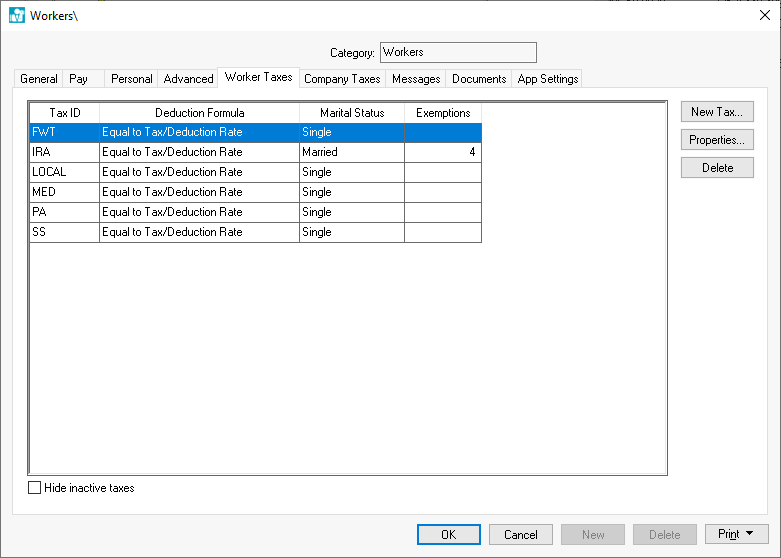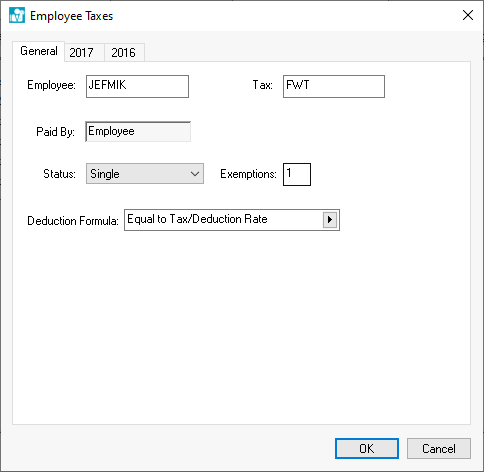Configuring Worker Taxes
All taxes or deductions that are deducted from a worker's pay must be
entered within the Worker Taxes tab. This
can include federal, state, or local taxes or other costs that are deducted
from the worker's pay. All taxes and deductions that are calculated
by the payroll process but are not deducted from the worker's pay should
be configured within the Company
Taxes tab.
Globally setup a tax or deduction for a group of workers, right click
on the worker category and select Edit Defaults
from the context menu. Review Workers
> Setting Worker Defaults for details on globally changing worker
information.
Complete the following steps to configure worker taxes:
Open the worker default
dialog or worker record.
Click on the Worker Taxes
tab:

- Click the New Taxes button to open the
following dialog:

- Select the Tax identification
code. Review Taxes
and Deductions > Adding New Taxes and Deductions for instructions
to add a new tax or deduction.
Select the Paid
By option as Employee.
The marital Status
will be copied from the employee’s Personal tab and should be kept
the same unless this particular tax is to be calculated using a different
marital status.
The number of Exemptions
will be copied from the employee’s Personal tab and should be kept
the same unless this particular tax is to be calculated using a different
exemption number.
The Extra Deduction
Formula is used to add an additional tax to the standard rate.
This formula should be set to Equal
to except for the following situations:
Set the Deduction
Formula to Inactive (no
taxable) to make the tax or deduction inactive. Note that
a tax cannot be deleted if history is present. Review the Taxes
and Deductions > Removing an Unused Tax Entry section for
more details.
To add
additional tax to the standard rate use the Add
__ % template to add additional percentage for this employee
or Add $__ template to
add additional dollar amount. This feature is useful if an employee
wishes to withhold an additional amount of Federal Withholding
Tax, or if an additional amount is deducted from one employee
compared to the other employees. It is best to set the appropriate
rate within the Tax/Deduction
window when possible, but the Deduction
Formula can be used to do deductions that are more complex
or variations.
To ignore Tax/Deduction
rate and manually set the deduction amount use the Is
$___ template to set the exact dollar amount of the deduction
or use Is ___% template
to set a percentage that is unique to this employee. These templates
will ignore any rates set within the Tax/Deduction window.
Click OK
to save. Repeat the steps listed above for each tax that you
wish to add or edit.
Deleting or Disabling a Tax
Highlight the desired Tax ID
and click on the Delete button
to remove a tax entry that has not been used. A tax or deduction cannot
be deleted but should be made inactive if any tax has been withheld. This
limitation is required so the employee history is not lost. Complete the
following steps to configure a tax or deduction as inactive:
Select
an existing tax and click on the Properties
button
Select
the Inactive (No Taxable)
option, as shown below:

Click
on the OK button to return to the tax list.
Click
the Hide inactive taxes option
ON if you wish to remove the inactive taxes from the list.
View History
Complete the following steps to view both
tax summary and details information:
Open the desired worker or company
tax or deduction record.
Click on the desired year tab as shown
below:tax and click on the Properties
button. Go to the appropriate year tab to view the tax or deduction
history for the entire year.

The history consists of 3 columns.
The Tax
amount is the total that has been withheld from the employee.
The Taxable
Gross amount is the employee’s total pay that was subject
to the tax or deduction.
The Total
Gross amount reflects the employee’s total gross including
both the taxable and non-taxable totals.
To view the source detail for both
the Tax and the Total
Gross columns right click on the total you wish to view and
select Drill down from the
context menu. From the details list select the pay date that you wish
to view and click Source to
view the timecard from which the tax or deductions was withheld.



